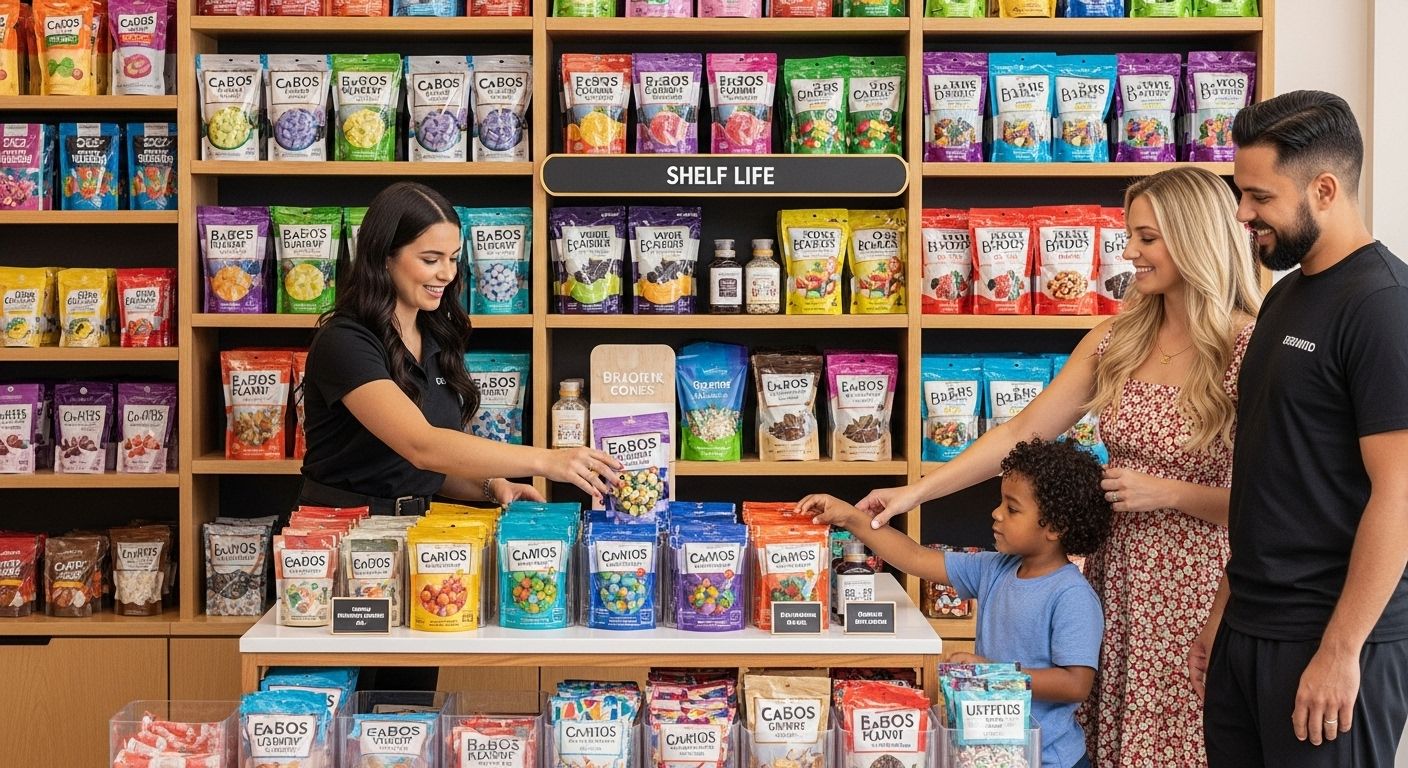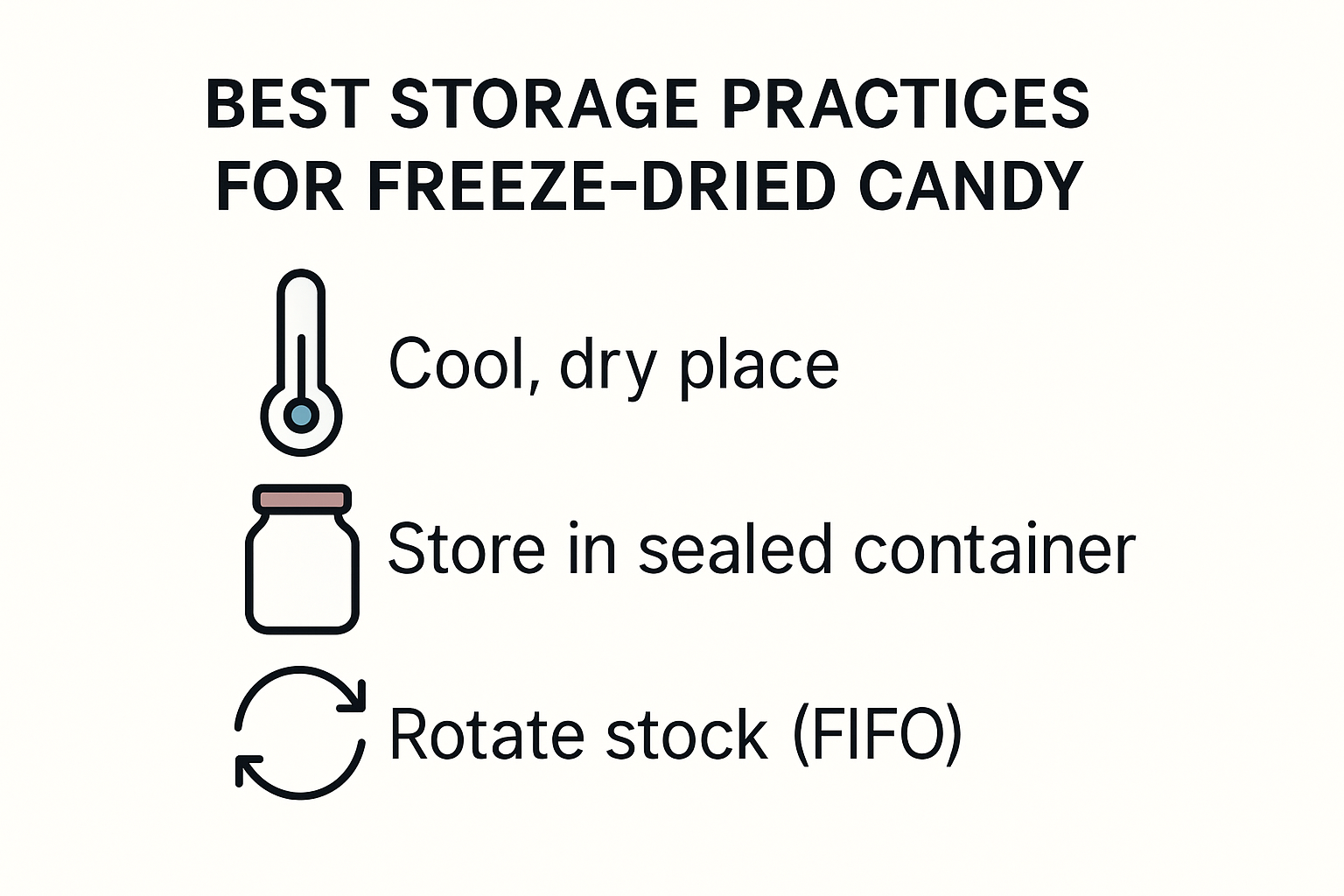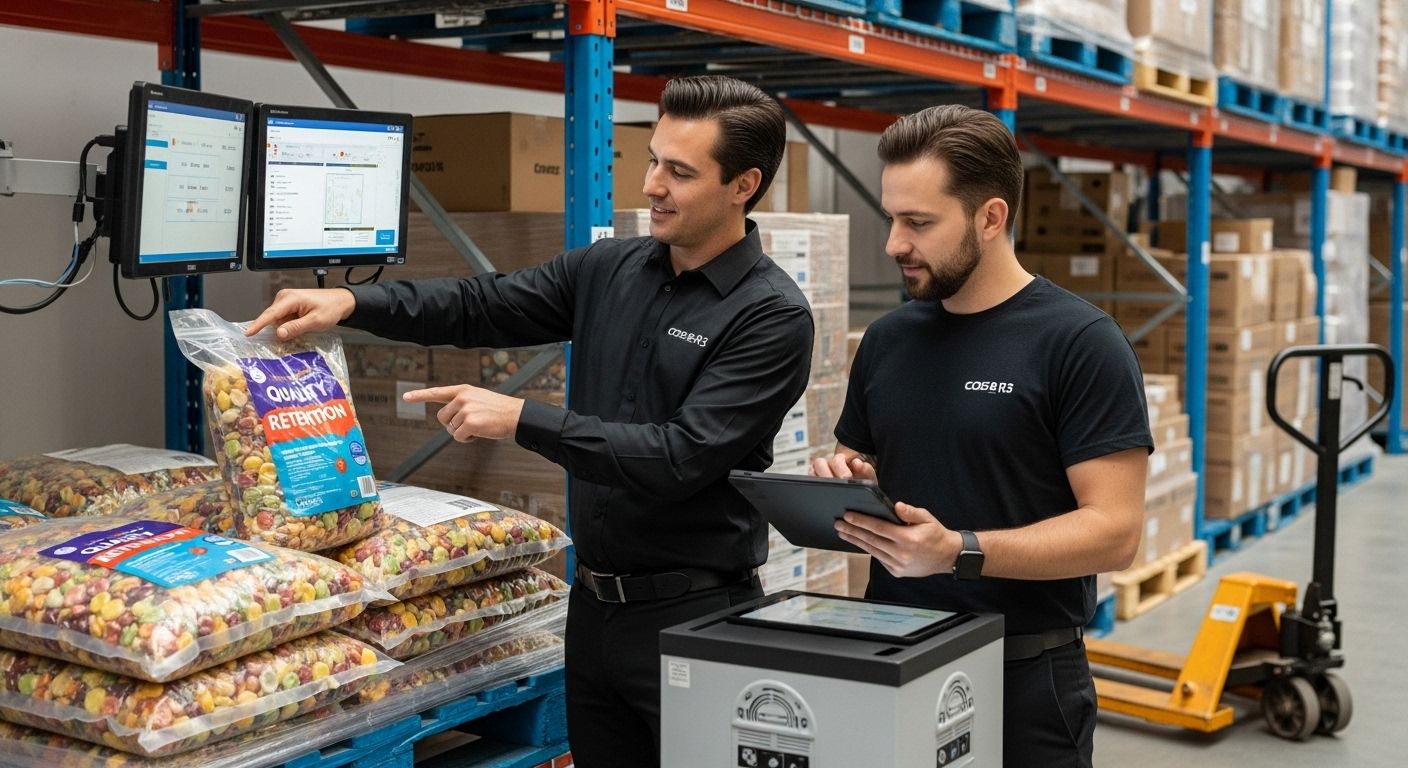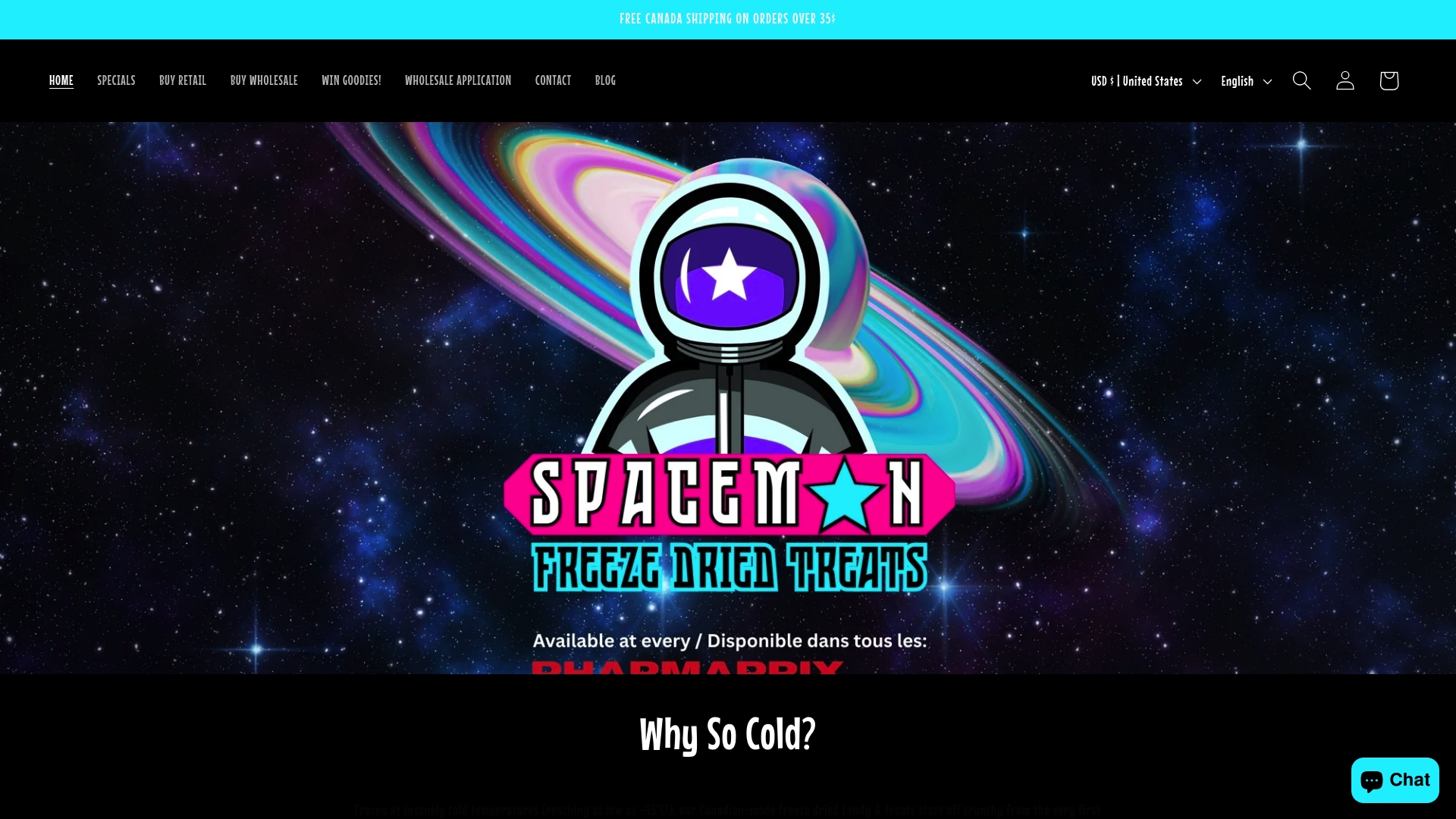
Les bonbons lyophilisés semblent presque indestructibles en rayon et les consommateurs apprécient leur texture légère et croquante ainsi que leur saveur intense. La plupart des gens sont surpris d'apprendre qu'ils peuvent conserver leur qualité pendant six mois, voire plus, s'ils sont correctement stockés. Mais la véritable surprise, c'est qu'une simple erreur, comme briser l'emballage hermétique ou laisser pénétrer une infime quantité d'humidité, peut les faire se gâter aussi rapidement que des bonbons classiques. Savoir comment préserver la fraîcheur des bonbons lyophilisés change complètement la donne en matière de durée de conservation.
Table des matières
- Qu'est-ce qui détermine la durée de conservation des bonbons lyophilisés ?
- Meilleures pratiques de conservation pour maximiser la durée de conservation
- Durée de conservation des bonbons lyophilisés pour les détaillants et les grossistes
- Signes indiquant que les bonbons lyophilisés sont avariés
Résumé rapide
| Emporter | Explication |
|---|---|
| Maintenir une faible activité de l'eau | Maintenir le niveau d'activité de l'eau en dessous de 0,6 pour prolonger la durée de conservation et inhiber la croissance microbienne. |
| Utilisez un emballage approprié | Utiliser des matériaux opaques, résistants à l'humidité et conditionnés sous vide pour protéger contre la dégradation et maintenir la qualité. |
| Contrôler la température et l'humidité | Pour une conservation optimale, conservez les bonbons entre 10 et 21 °C avec un taux d'humidité inférieur à 50 %. |
| Mettre en œuvre un système d'inventaire FIFO | Utilisez la méthode du premier entré, premier sorti (FIFO) pour minimiser le gaspillage et vous assurer que les stocks les plus anciens sont vendus en premier. |
| Reconnaître les signes de détérioration | Soyez attentif aux changements visuels tels que les altérations de couleur ou les problèmes de texture, qui sont des indicateurs de dégradation du produit. |
Qu'est-ce qui détermine la durée de conservation des bonbons lyophilisés ?
La conservation des confiseries lyophilisées repose sur des interactions complexes entre de multiples facteurs scientifiques et environnementaux qui influent directement sur leur durée de conservation et leur qualité. La compréhension de ces facteurs permet aux détaillants et aux fabricants d'optimiser la stabilité des produits et de garantir la satisfaction des consommateurs.
Pour vous aider à comprendre rapidement les principaux facteurs qui influencent la durée de conservation des bonbons lyophilisés, le tableau ci-dessous récapitule les principaux éléments de conservation et leurs rôles spécifiques :
| Facteur | Rôle clé dans la durée de conservation | Détails |
|---|---|---|
| Activité aquatique | Inhibe la croissance microbienne | Maintenir a_w en dessous de 0,6 |
| Contrôle de l'humidité | Prévient la détérioration et la perte de texture | Éliminer environ 98 % de l'humidité par lyophilisation ; protéger contre la réabsorption |
| Conditionnement | Protection contre les facteurs externes | Utiliser des matériaux opaques, résistants à l'humidité et conditionnés sous vide ; barrière contre l'air et la lumière |
| Température | Ralentit les processus de dégradation | Conserver entre 10 et 21 °C |
| Humidité | Prévient le ramollissement et la détérioration des produits. | Maintenir l'humidité relative en dessous de 50 % |
| protection physique | Préserve la structure et prévient les dommages | Utilisez un emballage robuste pour éviter tout écrasement ou contamination pendant le stockage et le transport. |
Contrôle de l'activité de l'eau et de l'humidité
L'activité de l'eau (a<sub>w</sub>) s'avère être un facteur déterminant de la durée de conservation des confiseries lyophilisées. Des recherches menées par des experts en sciences alimentaires indiquent que le maintien d'une activité de l'eau inférieure à 0,6 permet d'allonger considérablement la durée de conservation du produit. Cette valeur représente la quantité d'eau libre disponible pour la croissance microbienne et les réactions chimiques.
Le procédé de lyophilisation modifie profondément le profil d'humidité des confiseries en éliminant environ 98 % de leur eau. En créant un environnement à très faible humidité, les fabricants peuvent inhiber efficacement la prolifération bactérienne et la dégradation enzymatique. La faible activité de l'eau empêche le développement microbien, l'oxydation et la dégradation chimique qui compromettent généralement la qualité des aliments.
Emballage et protection de l'environnement
Les recherches spécialisées en matière d'emballage soulignent l'importance cruciale d'un conditionnement adéquat pour préserver la longue durée de conservation des bonbons lyophilisés. L'emballage idéal doit répondre simultanément à de multiples enjeux de conservation :
- Barrière anti-humidité : Empêche l'humidité extérieure de réintroduire de l'humidité.
- Protection contre l'oxygène : Minimiser les réactions d'oxydation susceptibles d'altérer le goût et la texture
- Protection contre la lumière : réduit les risques de dégradation de la couleur et de la saveur.
- Protection physique : Prévenir les dommages mécaniques pendant le transport et le stockage
Les emballages opaques sous vide, dotés de propriétés robustes d'étanchéité à l'humidité, contribuent à maintenir des conditions de conservation optimales. Les sacs en mylar avec revêtement barrière spécialisé offrent une protection supérieure contre les variations environnementales.
Conditions de température et de stockage
Les recherches menées par les services de vulgarisation agricole soulignent que des conditions de stockage constantes sont essentielles à la préservation de la qualité des bonbons lyophilisés. Les variations de température et d'humidité peuvent rapidement compromettre l'intégrité du produit.
Les paramètres de stockage idéaux comprennent généralement :
- Maintenir les températures entre 50 et 75 degrés Fahrenheit
- Maintenir l'humidité relative en dessous de 50%
- Conserver les produits à l'abri de la lumière directe du soleil
- Éviter les zones présentant d'importantes variations de température.
En maîtrisant ces facteurs environnementaux, les détaillants et les fabricants peuvent prolonger considérablement la durée de conservation des bonbons lyophilisés. Une gestion adéquate transforme ces confiseries potentiellement fragiles en friandises stables et durables.
Apprenez-en davantage sur les techniques de production de bonbons lyophilisés afin de comprendre comment le traitement initial influe sur les stratégies de conservation à long terme.
Meilleures pratiques de stockage pour maximiser la durée de conservation
Préserver la qualité et prolonger la durée de conservation des confiseries lyophilisées exige des stratégies de stockage qui vont au-delà des techniques de conservation classiques. Les détaillants et les distributeurs doivent mettre en œuvre des protocoles de stockage complets afin de garantir l'intégrité des produits et la satisfaction des consommateurs.
Sélection des contenants et intégrité de l'emballage
Le Centre national pour la conservation des aliments à domicile recommande d'utiliser des contenants propres, secs et hermétiques comme première ligne de défense pour protéger les bonbons lyophilisés. Le choix de contenants appropriés nécessite de prendre en compte plusieurs facteurs :
- Étanchéité à l'air : Les contenants doivent empêcher toute infiltration d'humidité et d'air.
- Compatibilité des matériaux : Matériaux de qualité alimentaire qui ne réagissent pas avec les ingrédients des bonbons
- Opacité : Contenants foncés ou opaques pour protéger contre la dégradation par la lumière
- Dimensionnement approprié : Contenants minimisant l'espace d'air excessif
Les sachets en mylar sous vide et les contenants en plastique alimentaire spécialisés, dotés de systèmes de fermeture robustes, assurent une protection optimale. Ces contenants créent une barrière contre les contaminants environnementaux tout en préservant la texture croquante et la saveur des bonbons.

Contrôle de la température et de l'humidité
Le service de vulgarisation agricole de Penn State souligne le rôle crucial des conditions environnementales dans la conservation des confiseries lyophilisées. Le manuel de l'ASHRAE fournit des informations détaillées sur la gestion de la température et de l'humidité.
- Les températures de stockage idéales se situent entre 50 et 70 degrés Fahrenheit.
- Maintenir l'humidité relative en dessous de 40 %
- Évitez les zones où les températures fluctuent.
- Conserver les produits à l'écart des sources de chaleur et de la lumière directe du soleil.
La réfrigération n'est pas toujours nécessaire pour les bonbons lyophilisés, mais elle peut s'avérer utile dans des environnements extrêmement chauds ou humides. Certains produits lyophilisés spécifiques peuvent nécessiter des plages de température particulières pour préserver leur qualité optimale.
Stratégies de stockage à long terme
La mise en œuvre d'une gestion systématique des stocks garantit une durée de conservation optimale et une qualité maximale des produits. Les stratégies clés comprennent :
- Rotation des stocks selon le principe du premier entré, premier sorti (FIFO)
- Inspections régulières de la qualité
- Manipuler avec précaution pour éviter tout dommage physique
- Tenue de registres détaillés des dates de production et de stockage
Les solutions de stockage professionnelles doivent inclure des systèmes de surveillance de la température, de l'humidité et des variations environnementales potentielles. Les technologies de suivi numérique peuvent alerter les responsables en cas de variations des conditions de stockage susceptibles de compromettre l'intégrité des produits.
Explorez les techniques avancées de production de bonbons lyophilisés pour comprendre l'impact des premières étapes de transformation sur leur conservation à long terme. Une préparation et un stockage adéquats sont essentiels pour obtenir des bonbons lyophilisés de haute qualité qui répondent aux attentes des consommateurs.
Durée de conservation des bonbons lyophilisés pour les détaillants et les grossistes
Les détaillants et les grossistes sont confrontés à des défis uniques en matière de gestion des stocks de confiseries lyophilisées, où la compréhension de la durée de conservation des produits a un impact direct sur la rentabilité et la satisfaction client. Une gestion stratégique des stocks exige une connaissance approfondie des techniques de conservation et de maintien de la qualité.
Facteurs de maintien et de dégradation de la qualité
Une étude publiée dans ACS Agricultural Science & Technology met en lumière la complexité de la prédiction de la durée de conservation des produits lyophilisés. Contrairement aux confiseries traditionnelles, les produits lyophilisés présentent des profils de dégradation nuancés qui vont au-delà d'une simple date de péremption.
Les principaux facteurs de maintien de la qualité comprennent :
- Stabilité du composé : Préservation des profils aromatiques originaux
- Maintien de la texture : Prévenir la réabsorption de l'humidité
- Préservation des couleurs : Minimisation de la dégradation des pigments
- Intégrité nutritionnelle : Maintien des concentrations initiales en nutriments
Une étude publiée sur PubMed et portant sur les en-cas lyophilisés au cassis a révélé que la plupart des produits conservent des attributs de haute qualité pendant environ six mois, avec des changements progressifs de texture et de couleur pouvant avoir un impact sur la perception du consommateur.
Stratégies de gestion des stocks
Un contrôle efficace des stocks exige une approche globale de la gestion des confiseries lyophilisées. Grossistes et détaillants doivent mettre en œuvre des processus systématiques qui concilient qualité des produits, efficacité du stockage et demande du marché.
Les stratégies recommandées comprennent :
- Mise en œuvre de systèmes de suivi robustes
- Réaliser des évaluations régulières de la qualité
- Établir des protocoles de rotation clairs
- Élaboration de mécanismes précis de prévision de la demande
L'analyse prédictive peut aider les entreprises à anticiper le cycle de vie des produits et à optimiser la rotation des stocks. La compréhension des périodes de dégradation potentielles permet une gestion proactive, réduisant ainsi le gaspillage et préservant la qualité des produits.
Considérations économiques et de qualité
Une étude de l'Université de l'Arkansas souligne les implications économiques de la stabilité des produits, démontrant comment les conditions de stockage influent directement sur leur viabilité commerciale. Les détaillants doivent trouver un équilibre entre les coûts de conservation et la commercialisation des produits.
Les considérations économiques essentielles comprennent :
- Minimiser la dégradation de la qualité liée au stockage
- Réduire les pertes financières potentielles liées aux stocks périmés
- Maintenir des structures de prix compétitives
- Garantir une qualité de produit constante sur tous les canaux de distribution
Une gestion professionnelle des stocks transforme les bonbons lyophilisés, produit potentiellement instable, en une offre fiable et rentable. Des contrôles environnementaux précis et des techniques de manutention stratégiques peuvent considérablement prolonger leur durée de vie commerciale.

Explorez des informations avancées sur la transformation des confiseries pour comprendre comment les méthodes de production initiales influencent la stabilité à long terme du produit et sa performance sur le marché.
Signes indiquant que les bonbons lyophilisés sont avariés
Les bonbons lyophilisés offrent une conservation prolongée, mais la détection précoce des signes de dégradation est essentielle pour préserver leur qualité et garantir la sécurité des consommateurs. Reconnaître ces signes permet de prévenir les risques sanitaires et de protéger la réputation de la marque.
Le tableau suivant répertorie les signes visuels, tactiles et sensoriels courants indiquant que les bonbons lyophilisés sont peut-être altérés. Utilisez-le comme liste de contrôle pratique pour les inspections en magasin et les contrôles qualité :
| Type d'indicateur | Panneau de détérioration | Que rechercher |
|---|---|---|
| Visuel | Modification de la couleur | Assombrissement inhabituel, décoloration |
| Visuel | anomalies de surface | Résidu pulvérulent, cristallisation |
| Visuel | Développement de moisissures | Taches ou duvet visibles, même microscopiques |
| Texturé | Modifications de texture | Perte de croustillant, agglomération, aspect collant |
| Sensoriel | Changements d'odeur | Odeurs inhabituelles, rances ou désagréables |
| Sensoriel | Écart de saveur | Goûts sensiblement altérés ou désagréables |
| Physique | Problèmes de réabsorption d'humidité/d'emballage | Sensation molle ou collante, emballage endommagé |
Indicateurs visuels et texturaux
Le service de vulgarisation agricole de Penn State (Penn State Extension) fournit des informations complètes sur la détection de la détérioration des aliments. Pour les bonbons lyophilisés, les changements visuels et de texture constituent les principaux signaux d'alerte :
- Altération de couleur : Assombrissement ou décoloration inattendus
- Changements de texture : Perte de croustillant, apparition d'une consistance grumeleuse ou collante
- Anomalies de surface : Résidus poudreux inhabituels ou cristallisation
- Développement de moisissures : Toute croissance fongique visible, même des taches microscopiques
Les recherches menées dans le manuel ASHRAE sur le stockage indiquent que les fluctuations de température peuvent accélérer ces processus de dégradation, entraînant des modifications de qualité subtiles mais significatives.
Dégradation sensorielle et chimique
Au-delà des indices visuels, de multiples indicateurs sensoriels suggèrent une possible altération du produit :
- Changements d'odeur : Odeur inattendue ou rance
- Écart de saveur : Altérations de goût notables
- Réabsorption d'humidité : Une texture molle ou collante indique un emballage endommagé
- Contamination par les insectes : Petits trous ou traces d’intrusion d’insectes
Les réactions d'oxydation peuvent transformer en profondeur la composition chimique des bonbons lyophilisés, rendant indispensable une évaluation sensorielle rigoureuse. Des équipes de contrôle qualité professionnelles utilisent des techniques de détection avancées pour identifier les moindres signes de dégradation.
Protocoles de sécurité et d'élimination
Les directives de l'USDA en matière de sécurité alimentaire recommandent des protocoles stricts pour l'évaluation des produits lyophilisés potentiellement contaminés :
- Isoler immédiatement les stocks suspects
- Réaliser une évaluation complète de la qualité
- Observations détaillées du document
- Prévenir la contamination croisée
- Éliminez les produits douteux conformément aux normes réglementaires locales.
Les détaillants et les distributeurs doivent mettre en œuvre des procédures d'inspection rigoureuses. Une surveillance proactive minimise les pertes financières et protège la santé des consommateurs. Former le personnel à reconnaître les signes subtils de dégradation transforme le contrôle qualité d'une stratégie réactive en une stratégie préventive.
Découvrez des informations complètes sur la production de bonbons lyophilisés pour comprendre comment le traitement initial influe sur la stabilité et la sécurité du produit à long terme.
Foire aux questions
Quelle est la durée de conservation des bonbons lyophilisés ?
Les bonbons lyophilisés peuvent conserver leur qualité pendant six mois ou plus s'ils sont stockés correctement, bien qu'une simple erreur de stockage puisse entraîner une détérioration rapide.
Comment conserver les bonbons lyophilisés pour optimiser leur durée de conservation ?
Pour optimiser leur durée de conservation, les bonbons lyophilisés doivent être stockés dans un emballage sous vide, opaque et résistant à l'humidité, à une température comprise entre 50 et 70 °F et avec un taux d'humidité inférieur à 50 %.
Quels facteurs peuvent affecter la durée de conservation des bonbons lyophilisés ?
Les facteurs pouvant influencer la durée de conservation des bonbons lyophilisés comprennent le niveau d'activité de l'eau, l'intégrité de l'emballage, la température ambiante et les conditions d'humidité.
Comment savoir si des bonbons lyophilisés sont périmés ?
Les signes indiquant que des bonbons lyophilisés sont avariés comprennent des altérations de couleur, des changements de texture, le développement de moisissures, des odeurs inhabituelles et des variations de saveur.
Préservez la qualité de vos bonbons lyophilisés plus longtemps grâce à des solutions d'experts.
Vous avez du mal à conserver la fraîcheur et la qualité de vos bonbons lyophilisés plus longtemps ? Cet article souligne comment de petites erreurs d’emballage ou de contrôle de l’humidité peuvent anéantir des mois d’efforts et d’investissement. Les détaillants et les grossistes sont confrontés à des défis importants liés à l’activité de l’eau, à la gestion de la durée de conservation et à l’intégrité des emballages. Ces difficultés ont un impact direct sur votre rentabilité et votre réputation.

Évitez le gaspillage et assurez-vous que vos bonbons lyophilisés conservent leur texture croustillante et leurs saveurs intenses, de la production à la consommation. Faites confiance à Space Man , fabricant et distributeur canadien de bonbons lyophilisés. Nous proposons des services d'étiquetage privé, de conditionnement à façon et des solutions d'emballage avancées conçues pour protéger vos produits de l'humidité et des agressions extérieures. Prêt à vendre en toute sérénité ? Contactez-nous dès maintenant pour obtenir des solutions personnalisées adaptées à vos besoins en vente au détail, en gros ou en ligne. Agissez sans tarder pour garantir une conservation optimale de chaque sachet.
Recommandé
- Qu’est-ce que les bonbons lyophilisés ? Un guide complet pour les détaillants – L'astronaute
- Bonbons lyophilisés vs bonbons déshydratés : principales différences expliquées – L'astronaute
- Comment conserver les bonbons lyophilisés pour une fraîcheur optimale – L'astronaute
- Principaux avantages des bonbons lyophilisés pour le commerce de détail et les consommateurs – L'astronaute
- Comment choisir ses gommes à mâcher : un guide pratique pour les consommateurs de chanvre - Haygood Market

